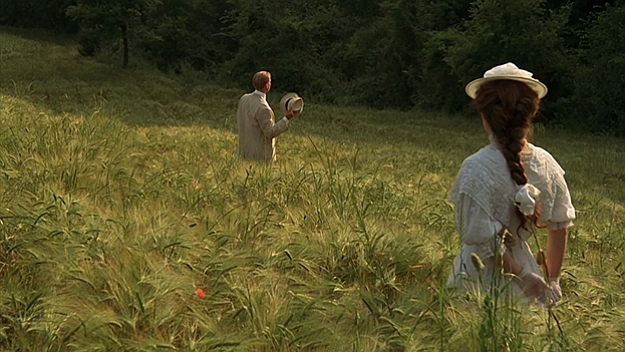 Facebook
Facebook
 X
X
 Instagram
Instagram
 TikTok
TikTok
 Youtube
Youtube

As promised, here are a few more moments of classical music in movies. For this group I’ve selected a personal axe to grind and a few well-known scenes.
Let’s start with my axe. At the 1999 Academy Awards, Gwyneth Paltrow won for best female actor for her role in the film Shakespeare in Love — which won for best picture.
This marked the beginning of the end for me and the Oscars because Cate Blanchett as Queen Elizabeth in Elizabeth had more dramatic content in her scat than Paltrow has managed to summon for her entire career. I have two words for you, “Pepper Potts.”
I submit two scenes from Elizabeth as examples of the effective use of classical music in a movie. The first scene is of Elgar’s Enigma Variations: Nimrod and the second is Mozart’s Requiem.
I think the choice of Mozart’s Requiem is obvious but the Nimrod could be considered gratuitous but effective.
For many, A Room with a View is the standard by which all others shall be judged. The exquisite use of Puccini’s Chi il sogno di Doretta from La Rondine only takes on a greater sheen when one understands the aria itself.
Never mind that the scene begins with Judi Dench, Maggie Smith, and Helena Bonham Carter. Just before the first line of the aria Judi Dench’s character is discussing a woman who married “a youth, ten years younger than herself.”
That line is the plot of La Rondine. The subtle brilliance of this inclusion should humble even the most erudite consumer of Merchant Ivory films. “Vain to deny.”
The Ride of the Valkyries from Apocalypse Now and Samuel Barber’s Adagio for Strings from Platoon go together for the purposes of this exploration. Both movies were controversial indictments of the United States’ actions in Vietnam and both starred a Sheen. The music, however, couldn’t be more different.
Wagner’s ultra-aggressive Air Cav soundtrack could not possibly find a more appropriate application and the poignancy of Barber’s Adagio makes Platoon a better movie than it really is.
Andy Dufresne’s act of defiance from Shawshank Redemption is included here because it’s a great scene even if the Letter Duet from Mozart’s Marriage of Figaro doesn’t make too much sense within the context of the movie.
Maybe I’m wrong and Susanna is trapped within the prison of the European caste system while the Countessa is sentenced to a loveless marriage. I think that’s giving Dufresne's aesthetic judgement too much credit.


As promised, here are a few more moments of classical music in movies. For this group I’ve selected a personal axe to grind and a few well-known scenes.
Let’s start with my axe. At the 1999 Academy Awards, Gwyneth Paltrow won for best female actor for her role in the film Shakespeare in Love — which won for best picture.
This marked the beginning of the end for me and the Oscars because Cate Blanchett as Queen Elizabeth in Elizabeth had more dramatic content in her scat than Paltrow has managed to summon for her entire career. I have two words for you, “Pepper Potts.”
I submit two scenes from Elizabeth as examples of the effective use of classical music in a movie. The first scene is of Elgar’s Enigma Variations: Nimrod and the second is Mozart’s Requiem.
I think the choice of Mozart’s Requiem is obvious but the Nimrod could be considered gratuitous but effective.
For many, A Room with a View is the standard by which all others shall be judged. The exquisite use of Puccini’s Chi il sogno di Doretta from La Rondine only takes on a greater sheen when one understands the aria itself.
Never mind that the scene begins with Judi Dench, Maggie Smith, and Helena Bonham Carter. Just before the first line of the aria Judi Dench’s character is discussing a woman who married “a youth, ten years younger than herself.”
That line is the plot of La Rondine. The subtle brilliance of this inclusion should humble even the most erudite consumer of Merchant Ivory films. “Vain to deny.”
The Ride of the Valkyries from Apocalypse Now and Samuel Barber’s Adagio for Strings from Platoon go together for the purposes of this exploration. Both movies were controversial indictments of the United States’ actions in Vietnam and both starred a Sheen. The music, however, couldn’t be more different.
Wagner’s ultra-aggressive Air Cav soundtrack could not possibly find a more appropriate application and the poignancy of Barber’s Adagio makes Platoon a better movie than it really is.
Andy Dufresne’s act of defiance from Shawshank Redemption is included here because it’s a great scene even if the Letter Duet from Mozart’s Marriage of Figaro doesn’t make too much sense within the context of the movie.
Maybe I’m wrong and Susanna is trapped within the prison of the European caste system while the Countessa is sentenced to a loveless marriage. I think that’s giving Dufresne's aesthetic judgement too much credit.
Comments